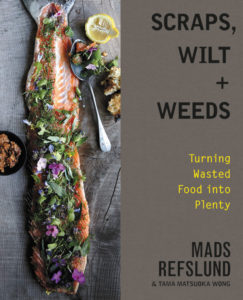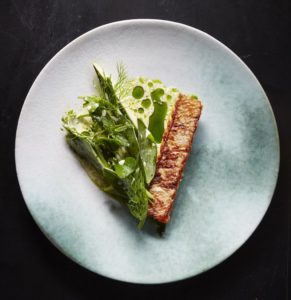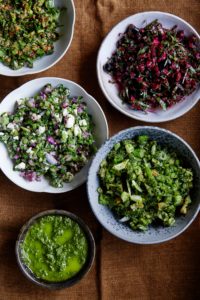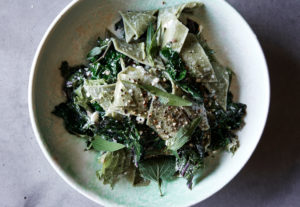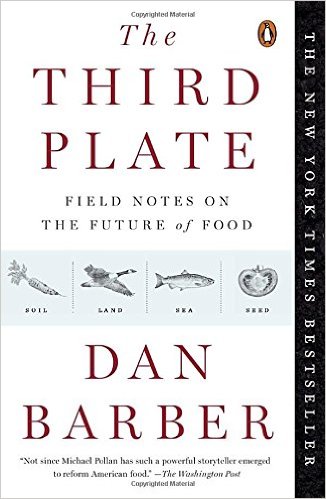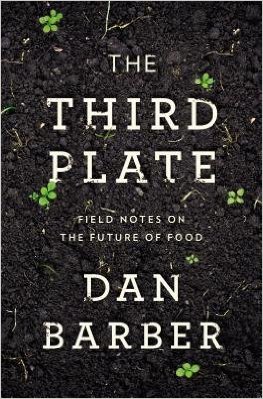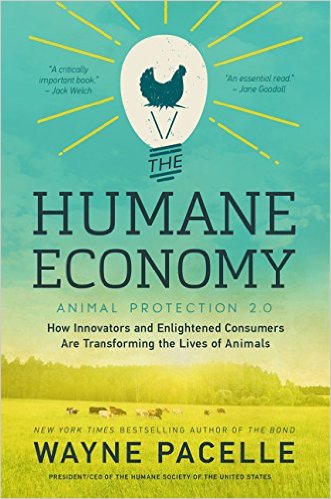Tag Archives: Food Systems
Glorious Food Waste
For decades, I have been gently chided, and occasionally mocked, for my kitchen frugality. A drawer filled with wilting produce sets off a visceral reaction leading to aggressive cooking. I don’t think it’s cheapness, as much as it’s a deep-seated concern about waste. Over the years, cooking teachers have denigrated the big, re-purposed Ziplock in my freezer chock full of plant scraps and leavings; apparently only pristine produce is good enough to make vegetable stock or fruit sauces. But still I persisted because, frankly, that just didn’t make any sense to me. And, besides, I just can’t empty that seemingly still good food into the trash or compost heap.
A short while ago, I stumbled on a wonderful “cookbook” Scraps, Wilt + Weeds written by Mads Refslund and Tama Matsuoka Wong. Refslund was a co-founder of world-famous Danish restaurant, Noma, and, shockingly, shares my visceral reaction to wilting, near-rotting produce! But he goes many steps beyond just making vegetable stock, dry-roasting just-past-prime produce, stewing less than perfect fruit into sauces and, of course, freezing very ripe bananas for breads and smoothies. Mads Refslund has elevated waste to haute cuisine.
The concepts are invigorating and inspirational – with stunning photographs that make near garbage extraordinarily beautiful. I use the word concept advisedly – to me the recipes are more conceptual than standard “multi-user-tested” ones. This is relatively new turf and the reader needs more guidance as to when, for instance, a tomato is near rot or just plain rotten. Even though I am a fairly accomplished home cook and long-time rescuer of wilted produce, I often had questions. For instance, a couple years ago I made carrot-top pesto from gorgeous, young CSA carrots and it was so bitter, it was inedible – why wasn’t his?
On the other hand, he encourages flexibility – use what you have (less, more or sub something else) rather than create more waste by buying to meet the specific recipe requirements. Other chapters focus on buying “ugly” produce, foraging for “weeds” and even using discarded fish parts. All told, it is a glorious paean to the minimization of waste and as I reluctantly released my non-renewable library copy, I concurrently added it to my Amazon list.
Mads Refslund has vindicated my kitchen frugality while he introduced others on whose shoulders he stands; those who have been long proselytizing waste reduction but who did not have his bully pulpit**. He has made reducing food waste sexy and chic. What a stunning, unbelievable accomplishment!! This is a book to own – a reference to stiffen our spines and alter our perceptions when we are about to sweep the leavings into the Waste King or the compost pot.
Why is this book so important? Every year, roughly 30% of all the food raised on the planet for human ingestion is literally wasted. If you just look at first world countries that number is even higher with the U.S. leading the pack at over 40%. According to the World Economic Forum, our global population is projected to reach 9.6 billion by 2050 – raising the leading question: how do we feed everybody? The United Nation’s FAO (Food & Agriculture Organization) posits that we already grow enough food, we just have to figure out how to save that 30-40% that we are currently wasting – which represents about 28% of the earth’s agricultural land. A whopping 25 percent of that waste is imperfect produce left in the fields to rot and 15% comes from tossed out, perfectly edible, food. (An additional, crucial, benefit would be to save the carbon footprint of all that wasted food –according to the EPA, landfills account for 34% of all U.S. methane emissions.)
** I am reading some of the author’s references and will share reviews and content in future posts.
My Take on “Veganism”
Up until a dozen years ago, we’d been innocently and happily eating a whole-foods, sugar-free, “healthy diet” for about three decades; it included low-fat dairy, white meat chicken and fish. But then, my husband “pushed through” on a New York Marathon feeder race, collapsed and was unceremoniously hauled off to a local hospital. That was when we learned that he had plaque on his arteries! I took this as a personal affront to my hard-won nutritional knowledge and culinary expertise.
After listening to my angst-ridden breast-beating, a friend handed me the “Eating” DVD (3rd Revision) – it was a revelation. The interviewees weren’t McDonald addicts or slab-of-beef on the plate types; these were people who’d been eating just like us. And their health profiles were just like ours. Once they embraced a whole-foods, plant-based lifestyle – aka veganism – their health improved: plaque disappeared from arteries, insulin requirements nose-dived, weight slid off…… We were smitten and embraced this new life-style with vigor and enthusiasm.
Today we’re still eating a primarily plant-based diet. We know that we’re healthier with it, that animals suffer less because of it and that the planet is better off (we could trade our Prius for a Humvee and our carbon footprint would still be impressive). But we’ve lost the religiosity. We prefer the term WFPB over Vegan because it is not so loaded. We still use the terms vegan or strict vegetarian in restaurants because plant-based does not compute with servers. But to the rest of the world, we call it a whole-foods, plant-based diet.
Over time, we’ve gotten easier with it. When we travel or dine out – especially at friends’ homes – we expand our options to include wild-caught salmon, mussels, oysters, brook trout and a couple other low-mercury, high omega-three, sustainable species (kudos to the Environmental Working Groups for simplifying this). Blue crab and lobster also make the few-times-a-year list because there are Crab Feast and Lobster Bake traditions on both sides of our families. On occasion, we also eat free-range “humanely raised” eggs. It makes life easier for everyone and, frankly, we welcome these occasional additional options. That said, when we are home, we eat a pretty strict WFPB diet – we like it; it’s easy and it allows us to “regroup” especially after long bouts of travel. When we entertain, it’s almost always a WFPB meal as well; we work hard at delivering luxuriously delicious meals that usually end with a dark chocolate dessert – and, hopefully, make the lack of animal products unnoticeable and irrelevant.
We don’t proselytize and only discuss our food choices when asked; we hope that this low-key approach might make the plant-based concept less off-putting and more appealing. It seems to us that the fewer animal products one eats and the more organic produce one consumes, the better off everyone is (for organic, we shop with the EWG’s Dirty Dozen [actually 20] and Clean Fifteen lists). As Columbia Professor Emeritus Joan Dye Gussow would say to the “Earth Friends” fourth graders: “it’s better for both worlds you inhabit – your body and your planet.”
We are fans of Meatless Mondays, Mark Bittman’s “VB6” (Vegan Before 6 pm), and any other variation that encourages people to dip a toe into this lifestyle. This is not a religion; it is a choice that is a win-win-win for you, for the animals, for the planet. Our philosophy is: just do what works for you; no one is taking notes.
FOOD CHAINS – The Revolution in America’s Fields
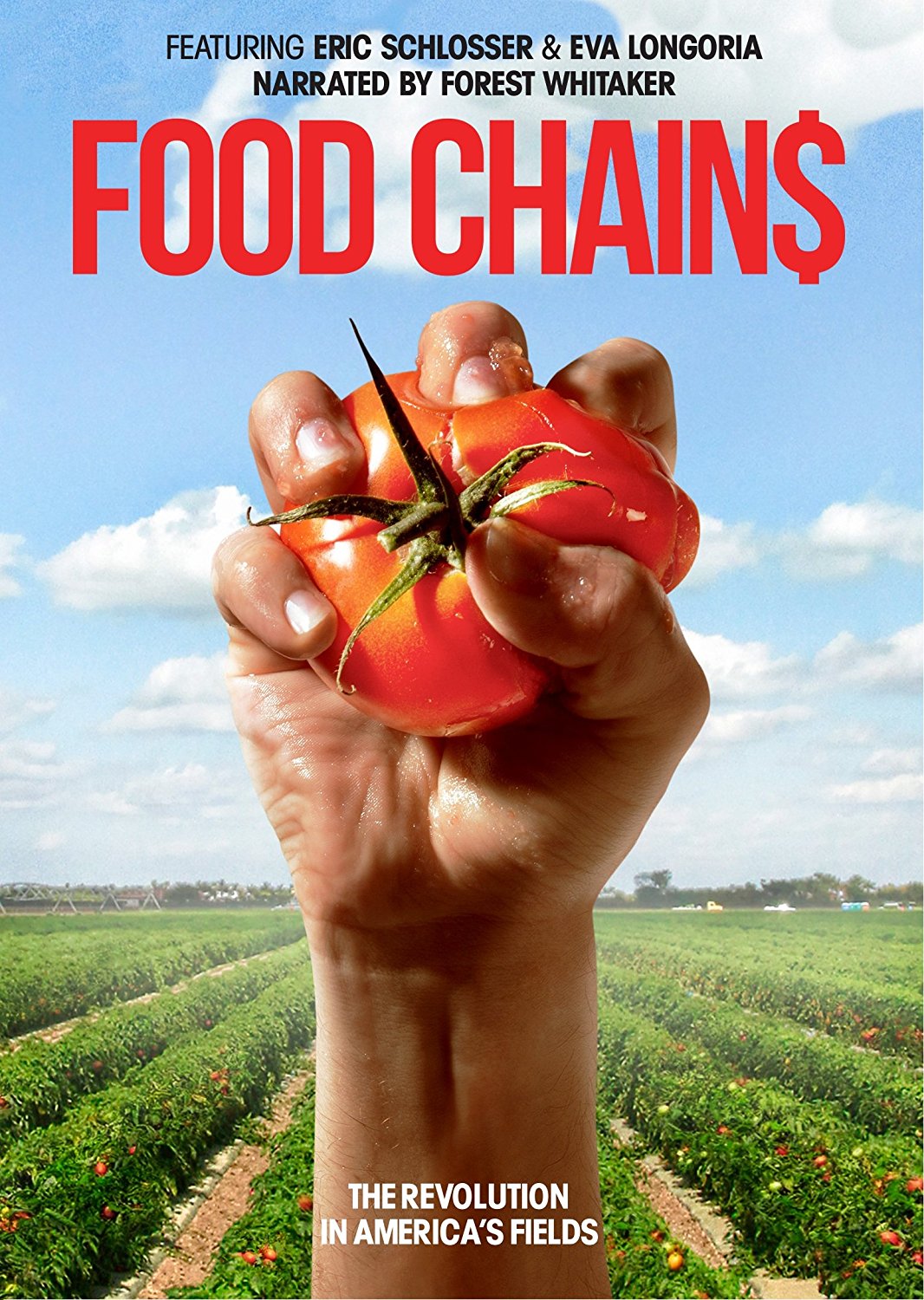
Director: Sanjay Rawal
Executive Producers: Eric Schlosser and Eva Longoria
Featuring: Eric Schlosser, Eve Ensler, Barry Estabrook, Dolores Huerta, Robert Kennedy Jr., Kerry Kennedy, Eva Longoria, Alma Martinez. Narrated by Forrest Whittaker.
Studio: Illumine Opportunity Group and Two Moons
Running Time: 1 hr. 22 min.
Released: 2014
Developed by Eva Longoria and Eric Schlosser (producer of Food Inc. and Fast Food Nation), this fair, accurate and exceedingly well-done documentary follows a group of migrant farmworkers who pick tomatoes (for Publix and Walmart) in the fields around Immokalee, Florida.
A small group of tomato workers have formed the CIW (Coalition of Immokalee Workers) to try to improve the deplorable conditions under which farmworkers live and work – and their target is Publix, the largest purchaser of tomatoes in Florida – a super chain worth $30 billion. If they just add a single cent to the wholesale cost of a pound of tomatoes it could double the workers’ pay. But Publix refuses to meet. There is a hunger strike – workers wielding signs line the roadways – but after six days that hasn’t gotten them any closer to a meeting.
The small farmer is caught in the middle; it’s a high stakes game every year. The answer seems to lie with the people at the top – the enormous buying power of the supermarkets. Similar problems exist in Florida’s pepper and cucumber industries. And in California as well. Which produces more fresh food than any other state and so has more migrant workers.
The problems started when Walmart got into the grocery business in the 1970s and everything changed. In order to compete the smaller chains had to consolidate into behemoth supermarket chains creating a Monopsony (a market situation in which there is only one buyer). Price reductions trickled down. The average daily pay for tomato pickers is $42 from 5am-8pm (about a penny per pound – paying another penny would double farmworkers wages). Some weeks, it’s $300-400 other weeks $100. The’r wages total about $10 -13,000 a year.
Sexual harassment of women farmworkers by their field managers is at 80%. The women are afraid to report the incidences for fear of losing their jobs. These are sweatshops in the fields. Actual, literal slave rings were also uncovered. After many protests, the CIW finally got Taco Bell to come aboard what became known as the Fair Food Program, and then Burger King, McDonalds, Chipotle, Trader Joes all eventually agreed to the Fair Food Tomato. Sexual harassment declined, wages increased (by one cent a pound). But the real top of the food chain remains the supermarket conglomerates – and they just won’t come to the table – as of 2014 the ICW had been asking Publix since 2010 to just talk to them. Continuing to embrace the process of creative non-violence – the sixth day of the hunger strike ended in a six mile walk. The ask: end harassment, slavery and pay just a penny more a pound – and talk to us.
In January 2014 Walmart agreed to join the Fair Food Program and expanded its reach to all farmworkers who pick produce here and elsewhere. Publix continued to refuse to even meet asserting that this is a farmer-worker dispute – not theirs.
A couple of asides were touched on but not developed: 1. we also see how these tomatoes are grown – massive amounts of pesticides are sprayed on the fields adjacent to the pickers – a deadly cooling breeze wafts across the field endangering the workers and the future consumers! 2. Floridian farmers are competing with Mexican tomatoes – and sometimes, it’s cheaper to dump the produce rather than pack and deliver. On the other hand, when Clinton signed NAFTA he pretty much tanked the Mexican produce market and small farms went under. 3. In the 60s, Cesar Chavez created the United Farm Workers of California. It wasn’t pretty but ultimately they prevailed. And then in the ‘80s conditions began to deteriorate again. 4, Napa Valley has evolved into the premier wine growing region of the world. Population doubles during harvest season. But the critical farmworkers can’t afford to live there so they have to commute long distances or live in homeless tent communities.
I briefly researched what has happened since the film was released, and as far as I can tell, in May 2016, Publix’s top tomato supplier Red Diamond Farm was fined $1.4 million and ordered to pay $150,000 in back wages for exploiting low wage workers. It appears that Publix continues its stand that this is between the farmer and the worker and that maybe the Feds should get involved. Well they did! And nothing more has happened since then. This film is very effective: For those of us who spend time in Florida, seeing how badly Publix comes off will impact where we shop.
HOW TO SEE IT: Amazon Prime – watch free, or buy the DVD $4.94 or Blu-Ray $12.89
The Humane Economy: how innovators and enlightened consumers are transforming the lives of animals
by Wayne Pacelle, Presdient & CEO of the Humane Society of the United States. William Morrow. April 2016. Hard Cover $18.38, Paperback $12.99 (March 2017), Kindle $12.99
Mr. Pacelle covers the whole enchilada of animal abuse in the US – from puppy mills and dog fighting to battery cages and gestation crates to animals in film, wildlife management, animal testing to stepping outside the US to Africa’s wildlife. It’s an upbeat, well-done, informative overview that hails the HSUS’ successes but with only one chapter devoted to each issue, depth, naturally, suffers. That said, the case studies on PetCo and PetSmart that describe how lobbying moved them from selling puppies and kittens to partnering with local shelters to host pet adoptions were impressive. My interest in reading it was to hear his perspective on factory farming and if that is your sole interest, then the two chapters devoted to this topic might not justify the purchase, but if your library has it, then by all means borrow it. It’s a good read and will draw you into areas of animal abuse that may not have been on your radar screen. Note: I read this in hard cover; there’s also Kindle version and in 2017 a paperback – if the Kindle version is anything like the posted sample (devoid of paragraph spacing) then reading in that format will be challenging.
